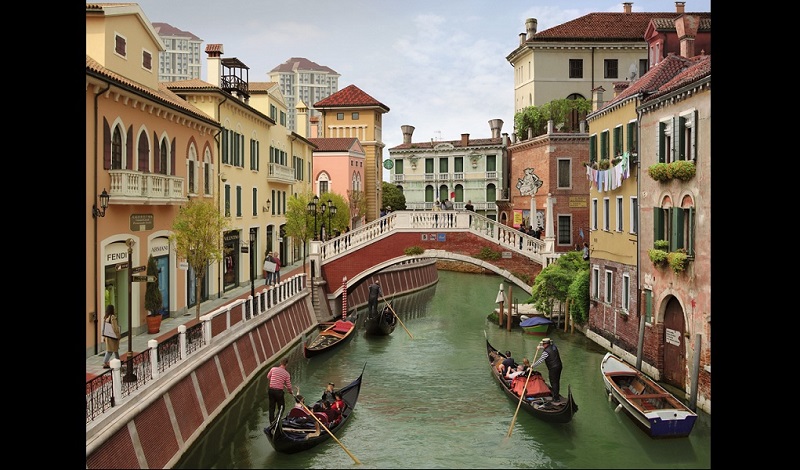Reviews & Articles
Review Emily Allchurch at Karin Weber Gallery
Jonathan THOMSON
at 12:33pm on 21st January 2021

Caption:
Emily Allchurch, Venezia Land (after Bellini)
(原文以英文發表,評論「Emily Allchurch: 鏡像城市」展覽。)
Emily Allchurch offers her viewers moments of perfect clarity by making photographic images in which every element is tightly focused and presented in high definition detail. Photography promises a version of reality but there is always a lie in there somewhere, given that every image is the result of conscious choices by the photographer about what to include and how to present it. For Allchurch, the deception is explicit, because while her images are made up of thousands of fragments of reality, the intention is to create fictional narratives that delight the eye and spur the imagination.
A work which strikes an immediate chord with Hong Kong audiences is “Babel Hong Kong”, which is an invented landscape based on “The Tower of Babel” by Pieter Bruegel the Elder, now in the Kunsthistorisches Museum in Vienna. Bruegel’s tower takes the form of a vast spiraling ramp, with a fairly uniform series of buildings lining the lower levels of the ramp, while the top section appears to be still under construction. Allchurch’s version has a similar composition but her work is a joyful amalgamation of bits of Hong Kong’s built environment, with each clearly identifiable element seamlessly joined to the next. Her work offers pleasure not just in the fun of identifying as many individual bits as possible, but also in the shock afforded by her new associations and surprising juxtapositions.
She describes her practice as “starting with an intensive encounter with a city or place, to observe and absorb an impression, and gather an extensive image library. From this resource, hundreds of photographs are selected and meticulously spliced together to create a seamless new space. Each artwork re-presents this journey, compressed into a single scene in order to focus on a social narrative”.
Lewis Carroll’s “Through the Looking-Glass” is one of the best loved classics of children’s literature. In it, the heroine Alice finds her way into Wonderland by climbing through a mirror into a world where everything is reversed. Mirrors are supposed to offer a truthful image to the viewer, but of course, everything is the wrong way around.
In “Mirrored Cities I and II”, Allchurch takes her inspiration from literature, from Italo Calvino’s “Invisible Cities, in which the city of Valdrada is described as two cities, one reflected in the other. Nothing happen in the first that is not repeated in the other. Both of these works have the same composition with sprigs of foliage in the top corners and culturally significant objects in the bottom corners and a horizontal band of buildings in the centre that are viewed across a body of water and ostensibly reflected in it.
In “Mirrored Cities I” it is the Chinese city of Fenghuang which is presented as the “real” although we note that the sprigs of foliage at the top are more Western in appearance, and the scene is foregrounded by elements from Venice. In “Mirrored Cities II” it is a line of Venetian palazzo’s that are presented as real, although framed at the top by more Eastern-style sprigs of blossom and coloured leaves, and by Eastern motifs in the foreground. In both works the body of water reflects something that isn’t there - the buildings from its counterpart “sister city”. These works investigate parallels between Venice and a number of cities in China as the beginning and end points of the ancient Silk Road, and invite contemplation of the more recent “Belt and Road” global infrastructure development project of the Chinese government.
Her “Venezia Land (after Bellini)” offers a more layered reading. In this work the “mirror” is vertical, dividing the image into left and right. The right side depicts the reality of buildings fronting a Venetian canal, embellished in part with some of Allchurch’s witty fabrications. The left side depicts the reality of an entirely fake streetscape. The Venetian casino resort in Macau owned by Las Vegas Sands Corporation and controlled by billionaire businessman Sheldon Adelson includes a shopping mall based on Venetian architecture that includes canals and gondolas and is presented under the eternal sunshine of a Bellini inspired painted sky that is illuminated 24/7/365. Looming over the top of the canal-front buildings on the left hand side, and giving voice to the lie, are the top sections of a pair of Macanese high rise residential towers.
The wholesale appropriation of vast swathes of true Venetian art and architecture invite consideration of the meaning and impact of cultural capital, originality, authenticity, mass tourism, exploitation and globalisation. As an artist interested in time and place, Allchurch is likewise concerned about all of these issues. And given that her most recent series was made during the time of COVID19, it is also not surprising that some of her images are eerily devoid of people. This sadly, adds further veracity to her scenes.
|
|
|
|
|
|
